2021 HYUNDAI SANTA FE CALLIGRAPHY key
[x] Cancel search: keyPage 601 of 636
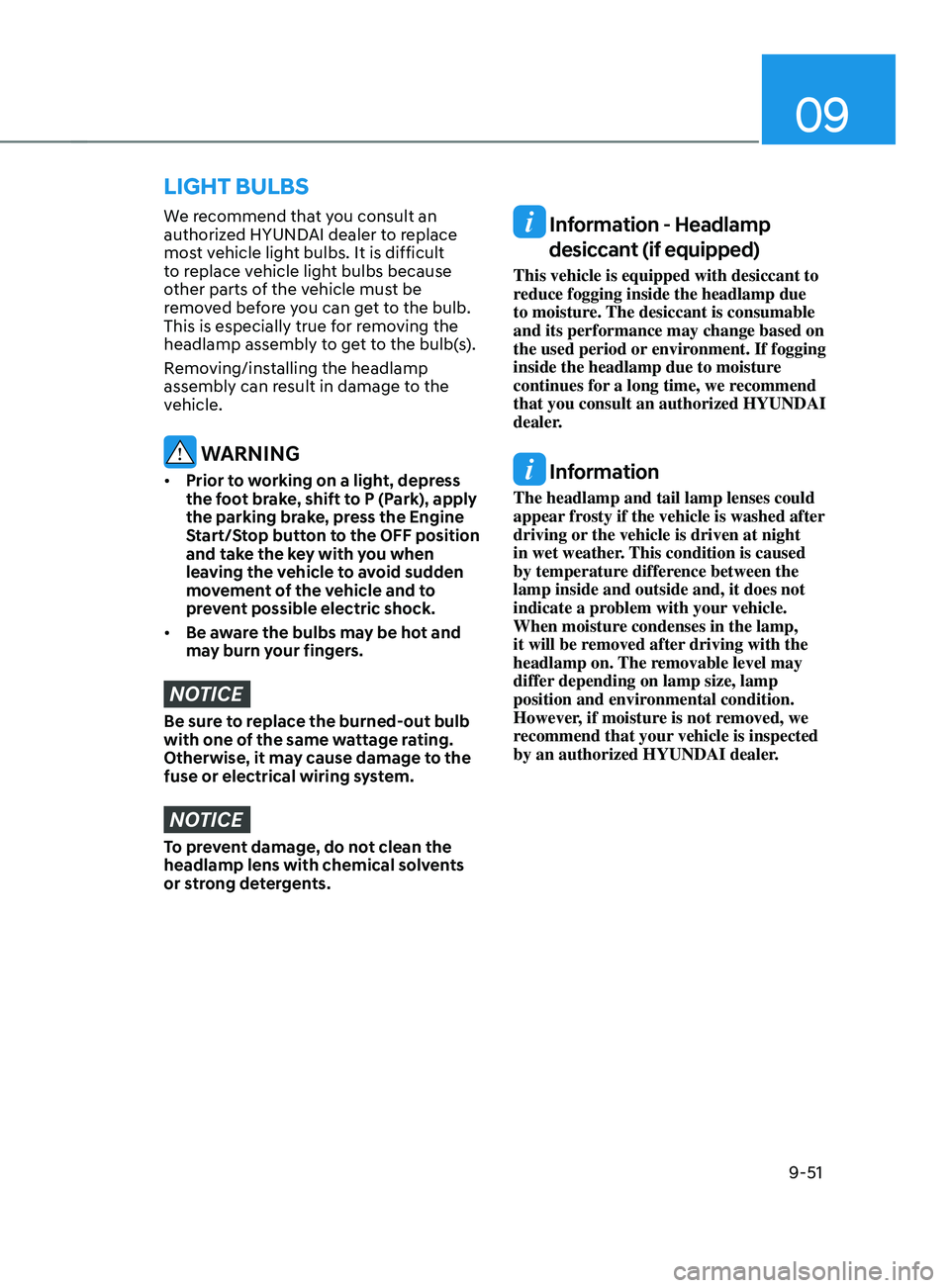
09
9-51
We recommend that you consult an
authorized HYUNDAI dealer to replace
most vehicle light bulbs. It is difficult
to replace vehicle light bulbs because
other parts of the vehicle must be
removed before you can get to the bulb.
This is especially true for removing the
headlamp assembly to get to the bulb(s).
Removing/installing the headlamp
assembly can result in damage to the
vehicle.
WARNING
• Prior to working on a light, depress
the foot brake, shift to P (Park), apply
the parking brake, press the Engine
Start/Stop button to the OFF position
and take the key with you when
leaving the vehicle to avoid sudden
movement of the vehicle and to
prevent possible electric shock.
• Be aware the bulbs may be hot and
may burn your fingers.
NOTICE
Be sure to replace the burned-out bulb
with one of the same wattage rating.
Otherwise, it may cause damage to the
fuse or electrical wiring system.
NOTICE
To prevent damage, do not clean the
headlamp lens with chemical solvents
or strong detergents.
Information - Headlamp
desiccant (if equipped)
This vehicle is equipped with desiccant to
reduce fogging inside the headlamp due
to moisture. The desiccant is consumable
and its performance may change based on
the used period or environment. If fogging
inside the headlamp due to moisture
continues for a long time, we recommend
that you consult an authorized HYUNDAI
dealer.
Information
The headlamp and tail lamp lenses could
appear frosty if the vehicle is washed after
driving or the vehicle is driven at night
in wet weather. This condition is caused
by temperature difference between the
lamp inside and outside and, it does not
indicate a problem with your vehicle.
When moisture condenses in the lamp,
it will be removed after driving with the
headlamp on. The removable level may
differ depending on lamp size, lamp
position and environmental condition.
However, if moisture is not removed, we
recommend that your vehicle is inspected
by an authorized HYUNDAI dealer.
LIGHT BULBS
Page 617 of 636
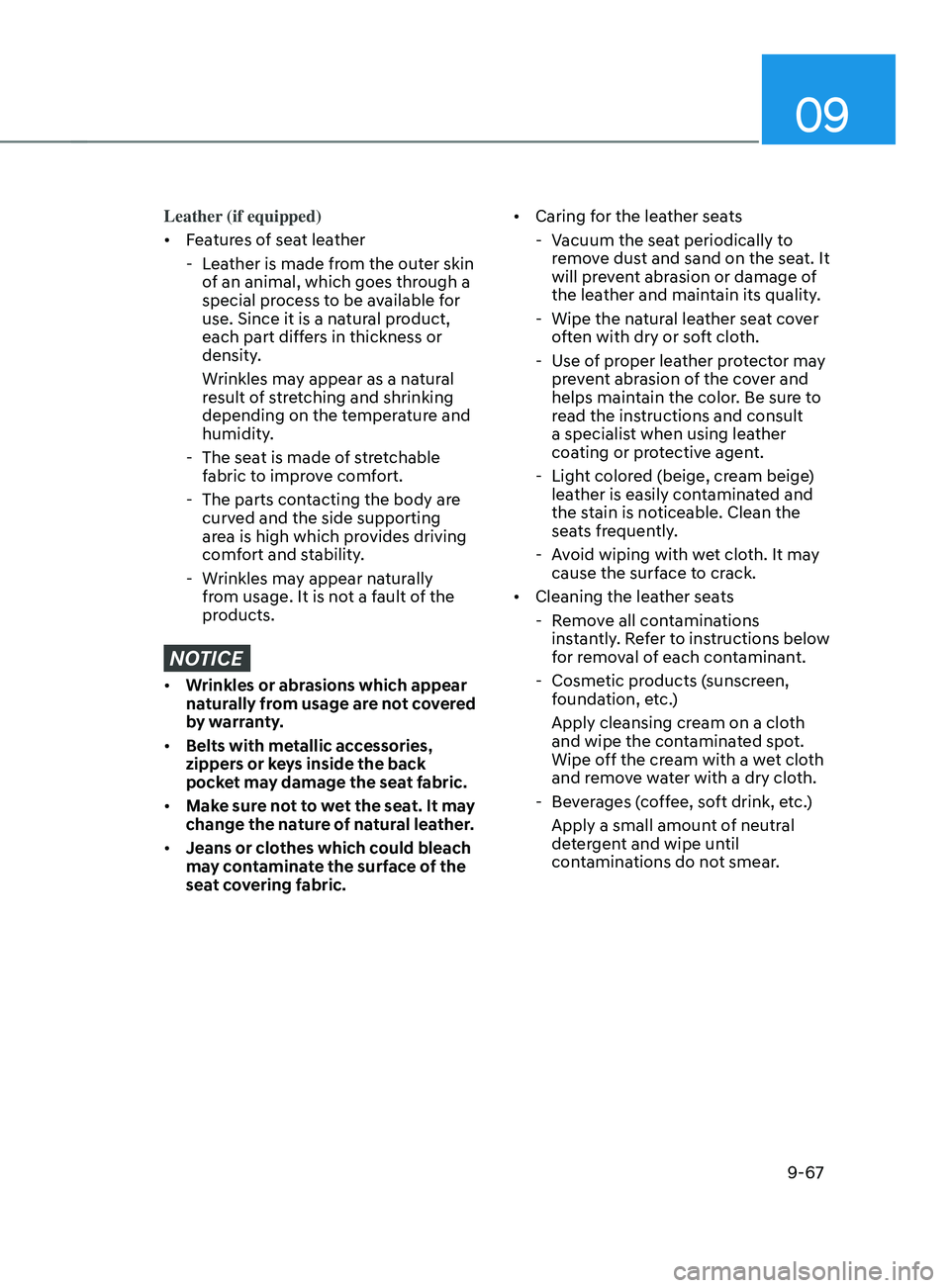
09
9-67
Leather (if equipped)
• Features of seat leather
- Lea
ther is made from the outer skin
of an animal, which goes through a
special process to be available for
use. Since it is a natural product,
each part differs in thickness or
density.
Wrinkles may appear as a natural
result of stretching and shrinking
depending on the temperature and
humidity.
- The seat is made o
f stretchable
fabric to improve comfort.
- The parts contacting the body ar
e
curved and the side supporting
area is high which provides driving
comfort and stability.
- Wrinkles ma
y appear naturally
from usage. It is not a fault of the
products.
NOTICE
• Wrinkles or abrasions which appear
naturally from usage are not covered
by warranty.
• Belts with metallic accessories,
zippers or keys inside the back
pocket may damage the seat fabric.
• Make sure not to wet the seat. It may
change the nature of natural leather.
• Jeans or clothes which could bleach
may contaminate the surface of the
seat covering fabric. •
Caring for the leather seats
- Vacuum the sea
t periodically to
remove dust and sand on the seat. It
will prevent abrasion or damage of
the leather and maintain its quality.
- Wipe the natur
al leather seat cover
often with dry or soft cloth.
- Use o
f proper leather protector may
prevent abrasion of the cover and
helps maintain the color. Be sure to
read the instructions and consult
a specialist when using leather
coating or protective agent.
- Light color
ed (beige, cream beige)
leather is easily contaminated and
the stain is noticeable. Clean the
seats frequently.
- Av
oid wiping with wet cloth. It may
cause the surface to crack.
• Cleaning the leather seats
- Remo
ve all contaminations
instantly. Refer to instructions below
for removal of each contaminant. - Cosmetic pr oducts (sunscreen,
foundation, etc.)
Apply cleansing cream on a cloth
and wipe the contaminated spot.
Wipe off the cream with a wet cloth
and remove water with a dry cloth.
- Bev
erages (coffee, soft drink, etc.)
Apply a small amount of neutral
detergent and wipe until
contaminations do not smear.
Page 622 of 636
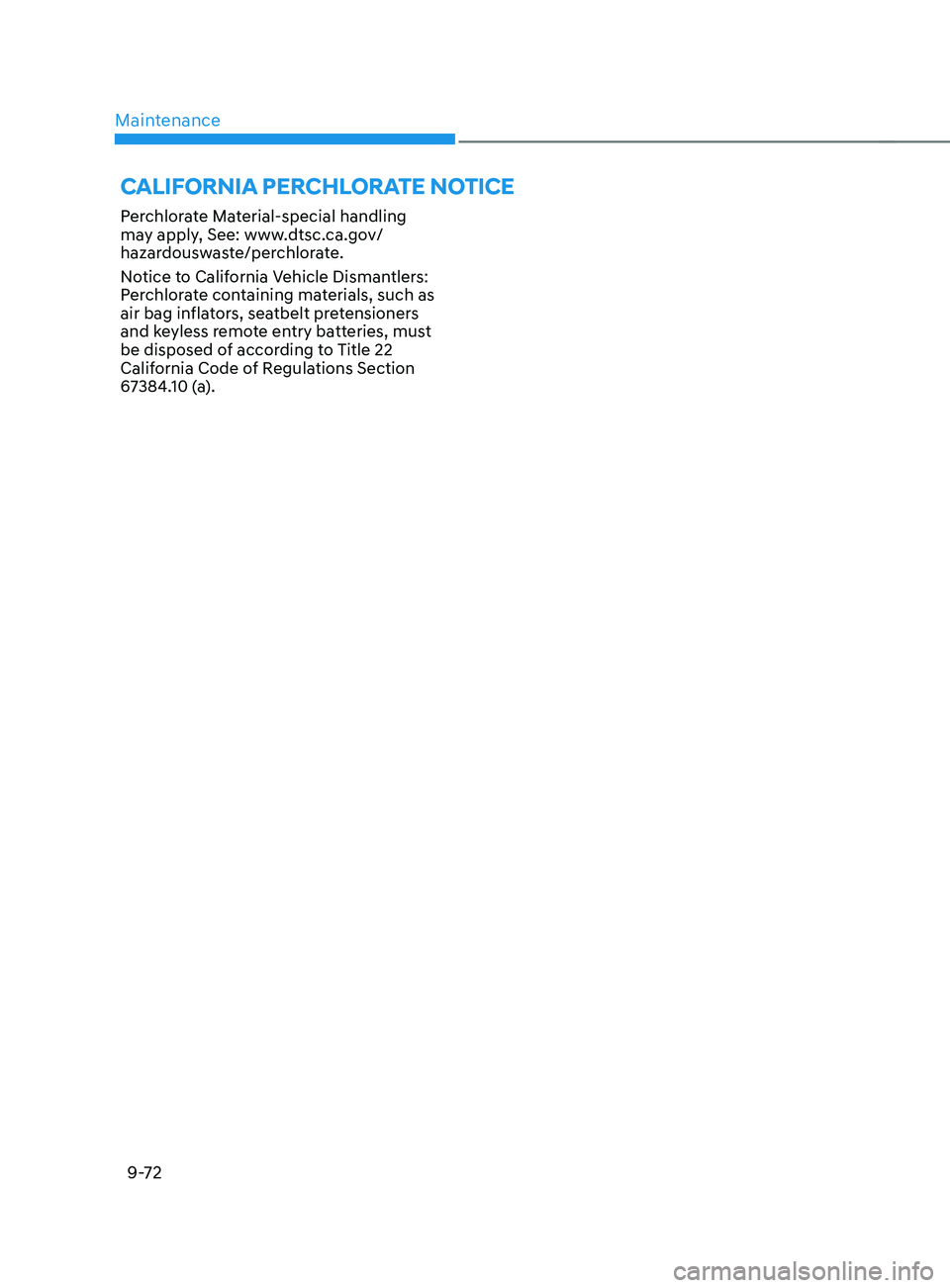
Maintenance9-72
CALIFORNIA PERCHLORATE NOTICE
Perchlorate Material-special handling
may apply, See: www.dtsc.ca.gov/
hazardouswaste/perchlorate.
Notice to California Vehicle Dismantlers:
Perchlorate containing materials, such as
air bag inflators, seatbelt pretensioners
and keyless remote entry batteries, must
be disposed of according to Title 22
California Code of Regulations Section
67384.10 (a).
Page 624 of 636
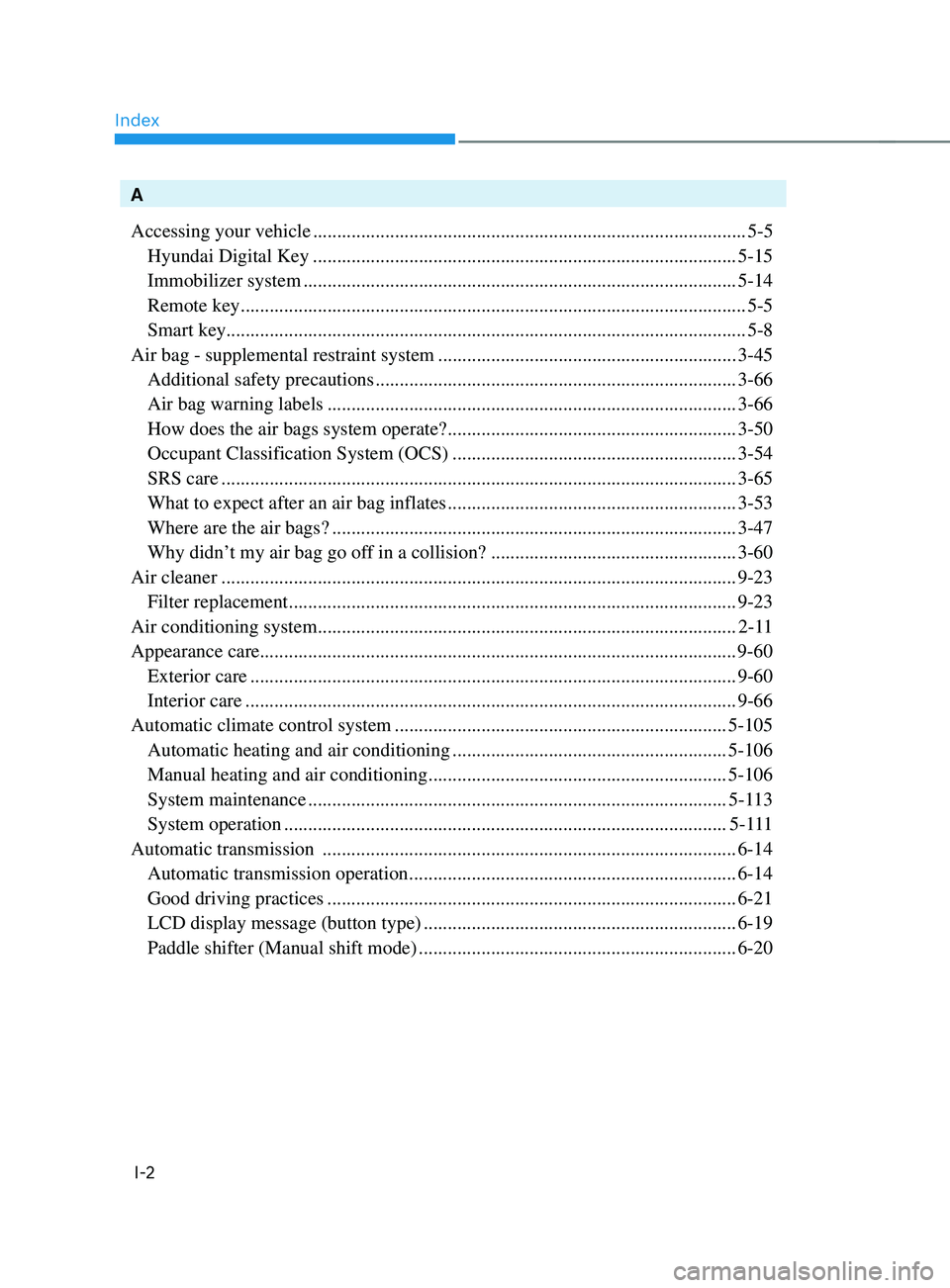
Index
I-2
A
Accessing your vehicle
........................................................................\
..................5-5
Hyundai Digital Key ........................................................................\
................5-15
Immobilizer system ........................................................................\
.................. 5-14
Remote key ........................................................................\
................................. 5-5
Smart key ........................................................................\
.................................... 5-8
Air bag - supplemental restraint system
.............................................................. 3-45
Additional safety precautions ........................................................................\
... 3-66
Air bag warning labels ........................................................................\
............. 3-66
How does the air bags system operate? ............................................................3-50
Occupant Classification System (OCS) ...........................................................3-54
SRS care ........................................................................\
................................... 3-65
What to expect after an air bag inflates ............................................................3-53
Where are the air bags? ........................................................................\
............ 3-47
Why didn’t my air bag go of
f in a collision?
................................................... 3-60
Air cleaner
........................................................................\
................................... 9-23
Filter replacement ........................................................................\
.....................9-23
Air conditioning system
........................................................................\
............... 2-1
1
Appearance care........................................................................\
........................... 9-60
Exterior care ........................................................................\
............................. 9-60
Interior care ........................................................................\
.............................. 9-66
Automatic climate control system
..................................................................... 5-105
Automatic heating and air conditioning .........................................................5-106
Manual heating and air conditioning .............................................................. 5-106
System maintenance ........................................................................\
............... 5-1
13
System operation ........................................................................\
....................5-
111
Automatic transmission
........................................................................\
.............. 6-14
Automatic transmission operation ....................................................................6-14
Good driving practices ........................................................................\
............. 6-21
LCD display message (button type) .................................................................6-19
Paddle shifter (Manual shift mode) .................................................................. 6-20
Page 629 of 636
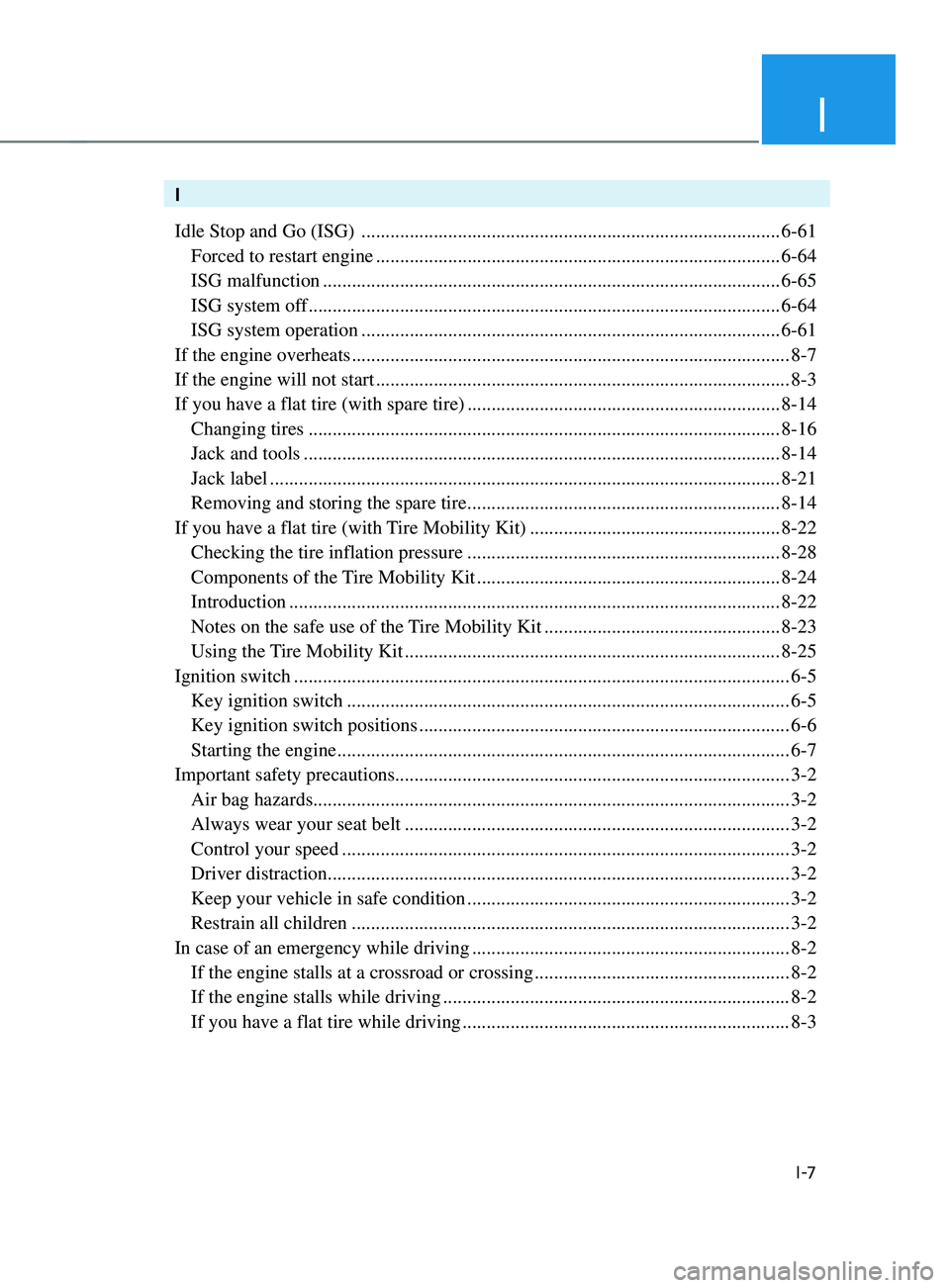
I
I -7
I
Idle Stop and Go (ISG)
........................................................................\
...............6-61
Forced to restart engine ........................................................................\
............6-64
ISG malfunction ........................................................................\
....................... 6-65
ISG system off ........................................................................\
.......................... 6-64
ISG system operation ........................................................................\
...............6-61
If the engine overheats
........................................................................\
................... 8-7
If the engine will not start
........................................................................\
.............. 8-3
If you have a flat tire (with spare tire)
................................................................. 8-14
Changing tires ........................................................................\
.......................... 8-16
Jack and tools ........................................................................\
........................... 8-14
Jack label ........................................................................\
.................................. 8-21
Removing and storing the spare tire .................................................................8-14
If you have a flat tire (with
Tire Mobility Kit)
.................................................... 8-22
Checking the tire inflation pressure ................................................................. 8-28
Components of the T
ire Mobility Kit
............................................................... 8-24
Introduction ........................................................................\
.............................. 8-22
Notes on the safe use of the T
ire Mobility Kit
.................................................8-23
Using the T
ire Mobility Kit
........................................................................\
...... 8-25
Ignition switch
........................................................................\
............................... 6-5
Key ignition switch ........................................................................\
....................6-5
Key ignition switch positions ........................................................................\
.....6-6
Starting the engine ........................................................................\
...................... 6-7
Important safety precautions
........................................................................\
.......... 3-2
Air bag hazards ........................................................................\
........................... 3-2
Always wear your seat belt ........................................................................\
........3-2
Control your speed ........................................................................\
..................... 3-2
Driver distraction ........................................................................\
........................ 3-2
Keep your vehicle in safe condition ...................................................................3-2
Restrain all children ........................................................................\
................... 3-2
In case of an emer
gency while driving
.................................................................. 8-2
If the engine stalls at a crossroad or crossing .....................................................8-2
If the engine stalls while driving ........................................................................\
8-2
If you have a flat tire while driving ....................................................................8-3